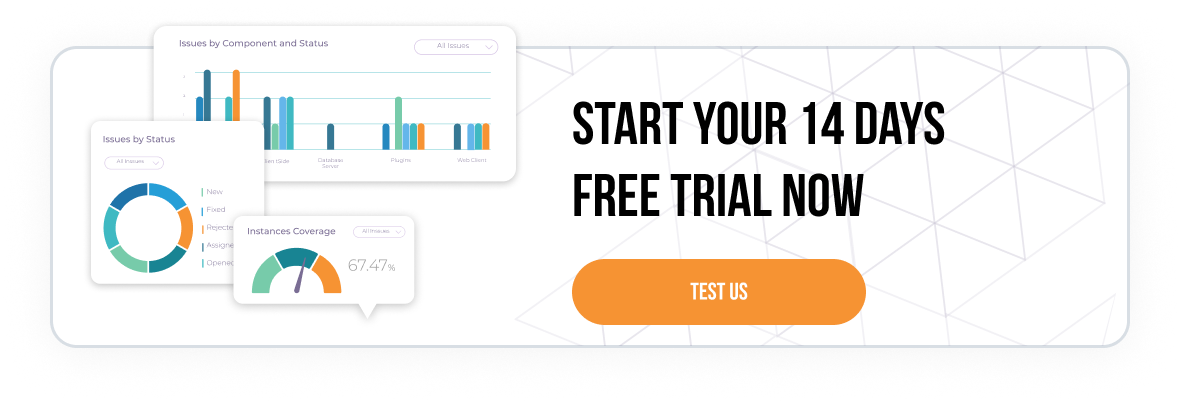How to Reorganize a Massive Test Case Library That’s Gone Out of Control
In This blog
Enterprise software test managers understand the pain of a disorganized test case library. Thousands of test cases, inconsistently written, scattered across the system, and duplicated multiple times. This chaos leads to wasted time searching, compromised test quality, and maintenance headaches, ultimately hindering testing efficiency. This blog is the first of a 3-part series that aims to provide a practical roadmap to help you reorganize your test case library for improved efficiency, maintainability, and testing effectiveness.

The Pains of Chaos
Imagine a library overflowing with books, haphazardly stacked on shelves. Finding a specific book that you are looking for becomes a frustrating task. This is precisely the challenge many organizations face with their software test libraries. Unstructured libraries can lead to:
-
Wasted Time: Tracking relevant test cases can be time-consuming, hindering testing progress
-
Duplication of Effort: The same test cases might be created repeatedly due to a lack of centralized visibility
-
Inconsistency: Test case quality and structure may vary, impacting the testing quality
-
Maintenance Challenges: Maintaining and updating test cases become cumbersome when they are scattered and poorly categorized. With many duplicated test cases, updating one instance might miss others with the same functionality, and testers may run outdated tests instead of the most updated ones.
When to Reorganize Your Test Library: Identifying Opportune Moments
A well-organized test library is essential for efficient testing, eventually contributing to achieving business goals. But how would you know when is the ideal time to start a library reorganization project? Here are some key indicators that signal the need for a strategic refresh:
Missed Business Requirements
This is the main reason to prioritize test library organization. As QA is tied to business success, missing crucial business requirements is a critical point that indicates your test effectiveness is low. Hence, reorganizing your test cases library is a necessary step. Here are some outcomes of disorganized test cases that might cause you to miss business requirements:
-
Incomplete Testing: Essential functionalities or workflows might not be covered due to difficulty in identifying relevant test cases. This can result in undetected severe defects that slip through testing and reach production, negatively impacting user experience.
-
Inefficient Use of Resources: Wasted time searching for test cases and inconsistencies in quality leads to inefficient use of testing resources. This translates to delayed testing cycles and potentially missed release deadlines, which can disrupt project timelines and impact business objectives.
-
Reduced Test Coverage: Disorganization makes it difficult to maintain comprehensive testing coverage. This increases the risk of having important tests falling between cracks.
Additional Opportune Moments:
While missed business requirements are the primary concern, other factors also indicate a good time to reorganize:
-
Implementing a new test management system: Transitioning to a new centralized test management platform presents a perfect opportunity to reorganize your library. The new system’s data organization methods can guide the process, ensuring a smooth migration of your tests and starting fresh with the platform.
-
Inefficiencies in Locating Test Cases: If testers spend excessive time searching for relevant test cases, it signifies a poorly structured library, which requires restructuring the library.
-
Inconsistent Test Case Quality: Variations in test case format, level of detail, or lack documentation practices indicate a need for reorganization to achieve consistent quality standards.
-
Duplication of Effort: If testers unknowingly create the same test cases over and over, it suggests a lack of centralized visibility. Reorganizing with a clear structure can eliminate duplication.
-
Business Process Changes: Significant changes in business processes might necessitate aligning test cases with the new workflows, therefore, updating the test library.
-
Project Growth and Complexity: As the number of projects and test cases grows, a well-organized structure becomes essential for maintaining control. Proactive reorganization can prevent future challenges.
-
Human Process: You are evolving as a QA leader and want to adjust your testing processes for enhanced results that will match you and your team’s capabilities.
By recognizing these opportune moments, you can initiate a reorganization project that optimizes your test case library and yields significant benefits in terms of efficiency, quality, maintainability, and finally, the successful fulfillment of business requirements.
This Test Case Library Health Check assessment can help you assess the impact and make decisions on when to start a Reorganization project.
Take the Test Case Library Health Check
The Power of Structure
A well-organized test case library offers significant advantages:
- Increased Efficiency: Testers can quickly locate the test cases they need, streamlining the testing process and working faster.
- Reduced Redundancy: An organized centralized repository eliminates the possibility of recreating existing test cases mistakenly.
- Improved Quality: Consistent and clear structure enhances the quality of test cases.
- Simplified Maintenance: Updates and modifications can be made easily and efficiently.
Building a Better Library: A Step-by-Step Guide
Here’s a practical roadmap to reorganize your test case library:
Phase 1: Assessment & Planning (1 Week)
Step 1: Evaluate Your Current State (2 Days):
-
Assess the current structure and identify areas for improvement. Consider factors like organization methods, test case granularity, and documentation practices.
-
Review Requirements to ensure your business scenarios are well covered by your test cases.
-
Conduct interviews with testers and stakeholders to understand existing pain points, categorization methods, and documentation practices.
-
Analyze a sample of test cases to assess consistency and level of detail.
-
Try to quantify the impact in order to build the business case for a test library reorganization project.
Step 2: Define Your Goals (1 Day)
Determine what you aim to achieve with the reorganization. Do you seek improved efficiency, better reporting, or easier collaboration? Define clear and measurable objectives, such as:
- Improve your requirement coverage by 15%
- Eliminating duplicate test cases by 30%.
- Increase tests reusability by 25%
- Lower maintenance efforts by 30%
Step 3: Choose a Structuring Method (2 Days)
Select a categorization system that aligns with your project needs, considering factors like project structure, application functionality, and testing methodology. Traditional options include:
- Project-based
- Functionality-based
- Feature-based
- Business Process-based
Traditional hierarchical structures often force you to categorize test cases into a single predefined folder. While hierarchical folder structures have been a mainstay in test management, their limitations in handling complex projects and evolving testing needs are becoming increasingly apparent.
Custom fields, on the other hand, empower you to go beyond the hierarchy folders and create a test case management method that truly adapts to your project’s unique requirements.
Step 4: Define Naming Convention (2 Days:)
Implement clear and consistent naming conventions for test cases to enhance searchability. Consider including project identifier, functionality and a brief description, for example:
SAP_Upgrade_Procurement_Login
Step 5: Define Test Case Attributes (2 Days)
Identify the information you need to associate with each test case. Examples include:
- Project Name
- Functionality Tested
- Business Process Tested
- Priority Level
- Automation Status (Optional)
- Creation Date
- Last Modified Date
Bonus: If your test management system allows you to create custom fields, expand your attributes even further. Add custom fields such as: Product, Feature, Module, App, etc.
Phase 2: Cleaning and Migration (3 Weeks)
Step 1: Cleansing (1 Week)
Review existing test cases and ensure consistency in format, style, and level of detail. Update or archive outdated tests. Decide which test cases will be migrated and which will be recreated from scratch.
Step 2: Standardization (1 Week)
Develop a guide for test case creation, including formatting, language, and level of detail.
Step 3: Migration Planning (2 Days)
Define the process for transferring test cases to the new system. This may involve manual migration or utilizing migration tools.
Step 4: Migration Execution (5 Days)
Transfer test cases to the new system, ensuring proper categorization and assignment of attributes.
Phase 3: Implementation and Training (1 Week)
Step 1: Establish Documentation Practices (5 Days)
Develop guidelines for documenting test cases, including steps, expected results, and pre-conditions.
Step 2: Train Your Team (2 Days):
Educate testers on the new structure, categorization methods, and best practices for creating and maintaining test cases.
Phase 4: New Test Case Creation (3 Weeks)
Launch a test case creation project to create all missing test cases.
Tip: If your Test Management Platform is powered with AI features for test case creation make sure you train your team to use it! This will help you further unify and standardize your test library.
Phase 5: Test Case Review (1 week)
Review your newly created test cases, to ensure they indeed comply with your defined standards, guides, etc. No testing should be done without proper testing.
Beyond the Basics: Practical Considerations
-
Leveraging Automation and AI Tools: Explore tools to streamline test case creation, execution, and reporting.
-
Integration with Other Systems: Consider integrating your test management platform with other tools like issue trackers or defect management systems.
-
Scalability and Future Growth: Design your system with scalability in mind to accommodate future project needs and test case volume.
Conclusion
Reorganizing your test case library is an investment that pays off in the long run. A well-structured library improves effectiveness, reduces redundancy, and enhances the overall quality of your testing efforts. By implementing the best practices detailed in this guide and creating a well-defined strategy for efficient reorganization of your test library, you can significantly improve the quality of your test cases.
Implementing an end-to-end test management system such as PractiTest, will allow you to manage your tests efficiently including hierarchical filters and custom fields, as well as integrating it with other tools you are using including bug trackers, automation tools, CI/CD tools and so on. This will ensure that all your testing efforts are located in one centralized repository for improved testing work.

























